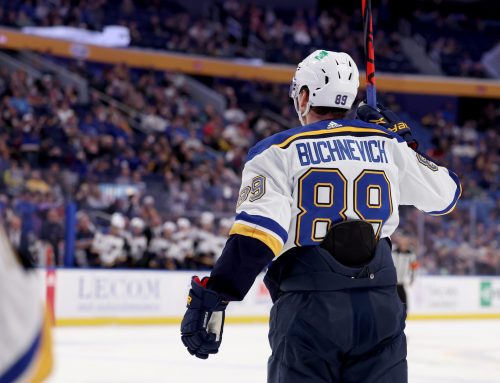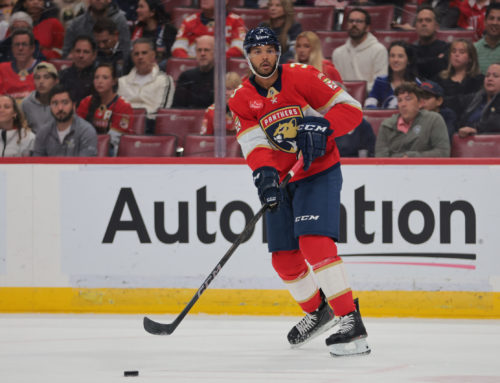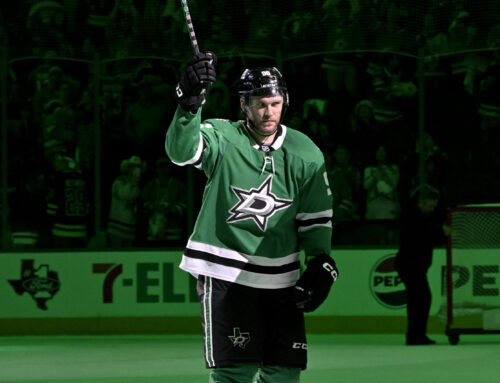
Getting through the drought with a look at Alex Galchenyuk, Sean Monahan, Filip Forsberg, Brayden Schenn and more …
***
It's dry out there.
So, in an attempt to create some talking points, I grabbed the top-20 goal scorers and top-20 point producers from after the All-Star break and looked at a handful individually.


Alex Galchenyuk
Talent playing with talent usually works, and here are Galchenyuk's linemates at five-on-five ranked by goals per 60 minutes, from Corsica. Only combos with at least 50 minutes of shared ice time were included.
.png)
As the No. 1 center between Max Pacioretty and Brendan Gallagher, Galchenyuk is poised for a breakout season, which should see him approach a point-per-game return.
He is crafty and opportunistic with all the necessary physical tools to be a high-end scorer, and with the right linemates, Galchenyuk will flourish.
Enter Michel Therrien, and the important reminder that we're not only analyzing the talent and opportunities of players. We need to handicap coaching situations and tendencies.
Galchenyuk's promotion up the depth chart as a pivot wasn't exactly Therrien's plan, it was more the result of having no alternative. With that said, hopefully Galchenyuk earned the gig going forward.
Aggressively targeting Galchenyuk this fall should pay off handsomely. After all, entering his age-22 season with three consecutive years of statistical growth bodes well for another jump forward.
Mikael Backlund
It was an incredible finish for Backlund in the goal column, especially since his previous career-high mark was 18. His 47 points were a personal best, and he registered them with fewer minutes (16:26) than he had played in each of the past two seasons (18:32 in 2013-14 and 17:45 in 2014-15).
Obviously, the ridiculously high 24.6 shooting percentage isn't sustainable, and Backlund is unlikely to receive the power-play time to buoy his totals. He received just 1:36 minutes of PP time last season.
There clearly is a respectable floor here, though, and especially since he should continue to play with viable offensive contributors on his flanks — Michael Frolik, Sam Bennett, Joe Colborne and Micheal Ferland.
It is also interesting that Backlund finished with a plus-10 rating to lead the Flames, and his 51 blocked shots were highest among forwards. So, next to his 155 shots and 68 hits, there is a pretty nice floor for the veteran center.
Don't count on 30 goals, but in deeper setups, Backlund is a nice late-round target because of his cross-category contributions.
Mark Scheifele
The Scheifele-Blake Wheeler-Nikolaj Ehlers trio is pretty solid. Below are the top-five combos with at least 200 minutes of shared ice time at five-on-five ranked by goals per 60 minutes, from Corsica.

Scheifele also threw together solid stretches in each of his previous two seasons, too.
November 23, 2013 through January 31, 2014

January 11, 2015 through March 26, 2015

So, after turning just 23 in March, Scheifele is set to dethrone Bryan Little as the top offensive center, and barring injury, have his true breakout season.
And while it would seem appropriate to stick with Ehlers and Wheeler, the top-nine group in Winnipeg has some interesting possibilities next season with Kyle Conner and Marko Dano potentially in the mix to go with Drew Stafford and Mathieu Perreault.
Some Patrick Laine gentleman is trying out for the team in September, too.
There are clearly some moving parts here, and just how it all shakes out won't be known this fall. With that said, though, Scheifele should have his matchups insulated by Little to some degree, which stands to help Scheifele's chances of returning a big season.
After the first few rounds, why not swing for the fences and chase a player on the edge of posting a huge season?
Filip Forsberg
How early is too early to draft Forsberg?
He finished as the 27th-ranked player, according to ESPN's Player Rater, and Forsberg finished 30th, according to Yahoo. Albeit, who knows how much stock to put into those ranks.
Regardless, it was the rookie wall that limited his production at the end of the 2014-15 season, and he improved in his sophomore campaign. He'll enter his age-22 season primed for another step forward and could have a legit No. 1 center for the first time of his career.
Plus, it was his underwhelming plus-1 rating that hurt him in the previously mentioned overall rankings, and we really shouldn't overly concern ourselves with the category at the stage of the draft Forsberg is being selected in.
He posted a plus-15 mark as a rookie, too, so he could easily rebound in the category.
What's most attractive is among players with at least 2,000 minutes of five-on-five ice time over the past two seasons, Forsberg ranks sixth in both goals per 60 minutes (3.15) and shots for per 60 minutes (34.97).
This is a dominant scorer that has returned these high-end statistics with Mike Ribeiro as his most frequent linemate. And while, Forsberg's numbers are better with Ribeio than without him, it is safe to suggest that is more based on Forsberg's chemistry with Riberio and lack thereof with others.
Entering his third-full season with an impressive resume, there are very few forwards who boast the floor-ceiling combo Forsberg does entering his prime offensive years.
Sean Monahan
While the pivot traded a few goals for helpers, it was nearly enevitable after posting a 16.2 shooting percentage in 2014-15. However, he did post a career-high 63 points with 20 even-strength goals for the second consecutive season.
Many will point to Johnny Gaudreau being a big factor in Monahan's production. The duo sports a solid 2.81 goals per 60 minutes at five-on-five over the past two seasons, and away from Gaudreau, Monahan has a 2.12 mark. Additionally, Gaudreau is better away from Monahan with a 2.98 G/60.
Still, despite being a slight concern, it would seem unlikely Gaudreau and Monahan land on opposite lines for long stretches. They're the one-two punch up front and have proven to be dynamic scorers.
But there are two notes to share.
First, Monahan and Gaudreau combined for 35 goals and 58 assists at home games this season and just 22 goals and 26 helpers on the road. The splits weren't nearly as drastic in 2014-15 (70 points at home versus 56 on the road), so the significant difference this season might prove to be an outlier.
However, the road struggles could also highlight the youngsters have difficulty when they don't have last change and opponents can dictate the matchups. It is something to watch for early next season, especially in daily contests.
Secondly, and please correct me if I'm wrong, Calgary doesn't have a bench boss yet. So, what was once a lock-solid combo atop the depth chart, might not be a guarantee to be again in 2016-17.
Additionally, sometimes new coaches flop (John Tortorella). Sometimes they're smashing successes (Mike Sullivan), too, though. All in all, we'll know more when the time comes, but adjusting to a new coach can limit offense, and it shouldn't be viewed as a given there will be an improvement behind the Calgary bench.
Finally, there might not be a lot of growth left for Monahan, and he might have already hit his plateau as a scorer. In his early 20s, he already has two 60-point showings, which is both valuable and impressive. But how much room for growth is there?
Under a new coach, look for Monahan's growth to be in the 200-foot game, which will likely mitigate most of his unfulfilled offensive upside. It'll make him a better real-world player, but he might stagnate as a scorer.
Brayden Schenn
It seems like it has been an up-and-down ride with Schenn over the past three seasons, but he has improved in the point column consecutively in each showing.
Schenn topped out at 26 goals and 33 helpers this year, which had a lot to do with Claude Giroux being his most-frequent linemate at five-on-five and the increased power-play minutes Schenn received.
Schenn spent an approximately 115 more minutes at five-on-five with Giroux last season (529:50 versus 445:01) and his average power-play time per game jumped from 2:59 in 2014-15 to 3:49 last year.
One interesting tidbit from this past year was Giroux produced just 1.96 goals per 60 minutes without Schenn and 2.49 with him. It isn't to say that Schenn carried Giroux, by any stretch, but it is telling of their development as linemates.
The top-six group in Philadelphia is strong enough for Schenn to remain a solid contributor away from Giroux, especially since Schenn has likely etched his role with the No. 1 power-play unit in stone after scoring 11 PP goals in 15-16.
It would seem unlikely Schenn takes another huge step forward in the point column, though. Turning 25 in August, he's still in his prime, but a lot went right for Schenn in 2015-16, as highlighted above, but he also posted a career-high 14.6 shooting percentage.
All said, counting on 55 points and hoping for 65 is advised.
***
Thanks, Dobberheads. Enjoy the weekend.
One Comment
Leave A Comment
You must be logged in to post a comment.





 TOR
TOR FLA
FLA VGK
VGK EDM
EDM DAL
DAL MIN
MIN CBJ
CBJ CAR
CAR WPG
WPG WSH
WSH ARI
ARI

Great Ramblings! There is some really interesting points in there.
Thanks!
Also, bought the Prospect Report and it’s gold as usual. Once quick suggestion/point of clarification – you do a good job of defining the Draft Advice (e.g. We tried to stick to a few different suggestions for you. These are:
1. A blue-chip prospect who you should take as early as you can.
Self explanatory. Even shallow leagues will want/need these guys.
2. He should be drafted in the first couple of rounds.
This player should be drafted early…)
But the Goalie Upside is a bit nebulous. For instance, I have no idea of the difference between “Game-stealing Starter” and “Star NHL Starter”. Which of those is preferential to the other?
I know it’s difficult to rank goalies at the best of times let alone when they’re 19 or 20 year old goalies but any edge I can get, right? ;-)
To all those who put in the work for that report, thank you. It’s a great resource and one of the products I really look forward to every year.
Cheers.